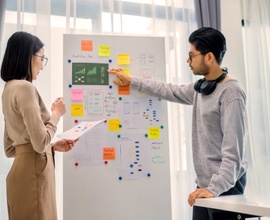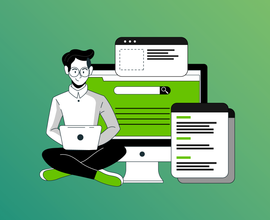Digital Marketing: Future Marketing Trends to Watch
What will the future of digital marketing look like? Two CMOs predict the future marketing trends that we can start preparing for.
The future of marketing is constantly changing. We know that. But we also know that trends emerge. So what trends can we use to predict where the marketing world is heading?
Future Marketing Trends To Watch
We asked two leading CMOS, Kathleen Schaub of IDC and Rishi Dave of Dun & Bradstreet , to give their predictions about how marketing strategies will change in the next five years. What will the future of marketing look like?
1. By 2020, More Than 50% of Commercial Content Will Be Created Outside of Marketing (IDC)
In the future, marketers are not going to be the primary creators of content. As Schaub explains it, “Content is democratic. The question you’ll have to ask yourself soon will be, ‘How can I adopt user-generated content?'”
2. Events Will Surpass Advertising as the Biggest Spend
Schaub predicts “a shift away from the semi-sterile digital world into the physical world.” With the increase in the amount of content accessible online, the value of in-person events will increase. Marketing budgets will reflect this increase, and you can expect to see event spending surpass advertising in 2017.

3. Marketing Will Displace Part of Your Sales Budget
Marketing job growth is outpacing sales, and you will see marketing budgets displace money that previously went toward sales efforts. Simultaneously, tech marketing budgets are lifting and further indicate that marketing spend will increase in the coming years.
4. B2B Marketers Will Spend More on Marketing Technology
77.6% of B2B marketers are increasing their marketing technology budgets in 2017. Budgets are increasing as marketers look to technology to provide data and insights.

5. Brands Will Shift Focus From Acquiring New Customers to Retaining Existing Customers
You will see fewer resources dedicated to early stage customer creation and more resources and money focused on middle and late stage efforts. The reason for this shift, Schaub says: “When you have better segmentation and data about your customers, you don’t have to spend as much money on customer creation.”

6. Brands Will Shift Their Social Marketing Efforts to Private Messaging Apps
You will see companies in the future shift their social marketing focus away from efforts in the public sphere towards private messaging groups and messaging apps. In other areas of the world, private messaging groups like WhatsApp and WeChat have already eclipsed emails as the primary way people communicate. We’re already seeing premium brands experiment with using these channels as marketing tools.
7. Team Enablement Will Be Crucial for Brands Moving Forward
IDC predicts that by 2020, 50% of digital transformation (DX) initiatives will fail due to the lack of an end-to-end customer experience orchestration service.
As companies start to think about their digital transformation, in almost every case they will have to revolutionize their customer experience. Traditional siloed marketing has got to go. You have to connect your data, your channels, and your teams moving forward.
8. Persona-Based Marketing Will Be Fundamental to Driving Growth
At our MOCCA networking event in New York City, Rishi Dave offered his own testimonial on the benefits of a persona-based approach.
Under pressure from the board to drive growth when he arrived at Dun & Bradstreet, Dave’s first instinct was to jump into the marketing tech stack, the content strategy, and the data and analytics.
But what he found quickly was that it doesn’t matter how great that data is if the company doesn’t have a firm understanding of who they are and why they’re different.
His first step was to establish a uniform mission statement and to change the company’s culture from a product-orientation to a people-orientation.
We don't sell products, we don't push products. We sell to actual humans. So the next step was to find out who the people are that we are selling to.
Focusing on ten accounts for the first few months, they began to see growth. As they moved forward and scaled their marketing efforts to address more accounts, they kept this persona-based approach in mind, and today it is responsible for much of their recent success.

![Seth Besmertnik, CEO and Co-Founder, [object Object]](https://cdn.sanity.io/images/tkl0o0xu/production/79e6eda2a43959d9ac71253ccff188677b8260d8-3542x3542.png?fit=min&w=100&h=100&dpr=1&q=95)






